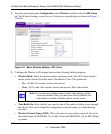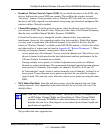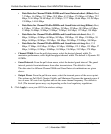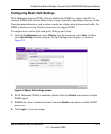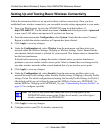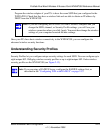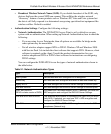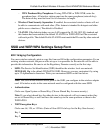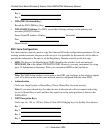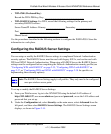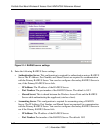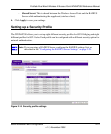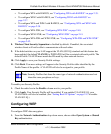
ProSafe Dual Band Wireless-N Access Point WNDAP350 Reference Manual
2-26 Basic Installation and Configuration
v1.1, November 2009
• Data Encryption. The available options depend on the Network Authentication setting
selected (see Table 2-1 above); otherwise, the default is None. The Data Encryption
settings are explained in the table below:
• Use of Passphrases and Keys are explained below:
– Passphrase. To use the Passphrase to generate the WEP keys, enter a passphrase and
click the Generate Keys button. You can also enter the keys directly. These keys must
match the other wireless stations.
– Key 1, Key 2, Key 3, Key 4. If using WEP, select the key to be used as the default
key. Data transmissions are always encrypted using the default key. The other keys
can only be used to decrypt received data.
WPA2-PSK
(WPA2 is a later version of WPA )
Only select this if all clients support WPA2. If selected, you must use
AES or TKIP + AES encryption and enter the WPA passphrase
(Network key).
WPA-PSK and WPA2-PSK This selection allows clients to use either WPA (with TKIP) or WPA2
(with AES). If selected, you must use TKIP + AES encryption and
enter the WPA passphrase (Network key).
a. All options are available if using Access Point mode. In bridge modes some options may be unavailable.
Table 2-2. Data Encryption Settings
Data Encryption Type Description
None No encryption is used.
Open WEP Can be used with WEP encryption or no encryption.
64 bits WEP Standard WEP encryption, using 40/64 bit encryption.
128 bits WEP Standard WEP encryption, using 104/128 bit encryption.
152 bits WEP Proprietary mode that will only work with other wireless devices that support
this mode.
TKIP This is the standard encryption method used with WPA and WPA2.
AES This is the standard encryption method for WPA2.
TKIP + AES This setting supports both WPA and WPA2. Broadcast packets use TKIP. For
unicast (point-to-point) transmissions, WPA clients use TKIP, and WPA2
clients use AES.
Table 2-1. Network Authentication Types
Type
a
Description



